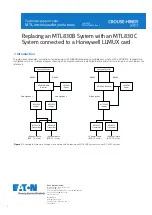
7. System Error and Trouble Shooting
7.1 Indicator lights
There are three LED indicator lights on the panel:
1)”POWER” is the power supply indicator, illuminates (in red) to show power supply is
working orderly.
2)”STATUS” illuminates (in green) to show the input signal is in order.
3)”ALARM” illuminates (in green) to show all parts are working orderly
7.2 Trouble Shooting
7.2.1 The ”POWER” indicator light does not illuminate.
Please check the wire to make sure the wire is connected to the socket properly and the
power switch is on.
7.2.2”STATUS” illuminates (in red)
This means the parameters are been setting.
7.2.3”AlARM”flashes
This means the unit is out of order, pleas refer to following:
It shows “ IN TS NO SIGNAL”: The input signal of ASI interface is not in order or no
input signal. Please check the ASI input signal source and connecting cable.
It shows “CH01 FIFO FULL”: There is some data overflow from the first input interface,
the signal will have the error coding and the unit can’t work orderly. It needs to increase
output data rate or deduce the output programs.
7.3 Note
A. The output bit rate of MUX should be slight higher than the summation of input
bit rate, otherwise the MUX will work unorderly.
B. The output bit rate of MUX should be slight lower than the input bit rate of QAM
modulator.
C. The relation between input available bit rate of QAM modulator and symbol rate
of IRD-C:
Input available bit rate =symbol rate *
m *
188/204
Input available bit rate is 188 bytes data.
For Example: Input available bit rate = 38.014Mbps (64 QAM modulation)
Symbol rate= Input available bit rate* 204
/
188
/
6=6875Kbps
m=2,4,5,6,7,8,
correspondence to QPSK,16QAM,32QAM,64QAM,128QAM,256QAM
7-1

































